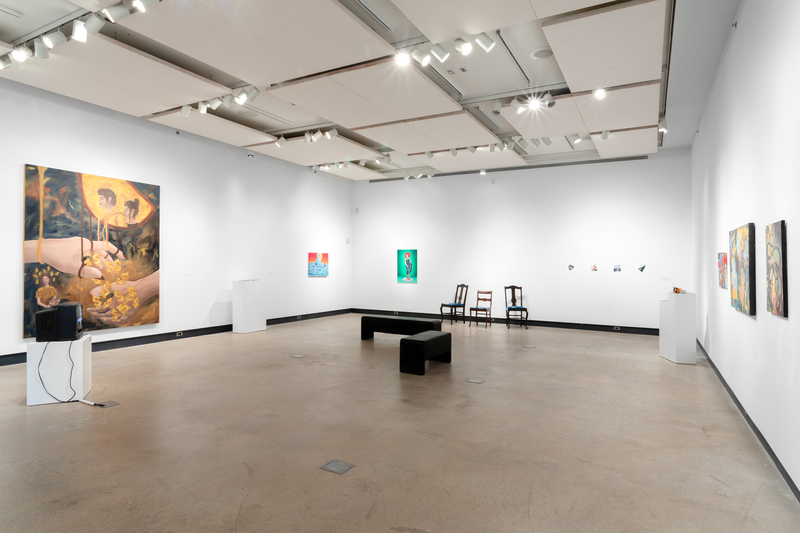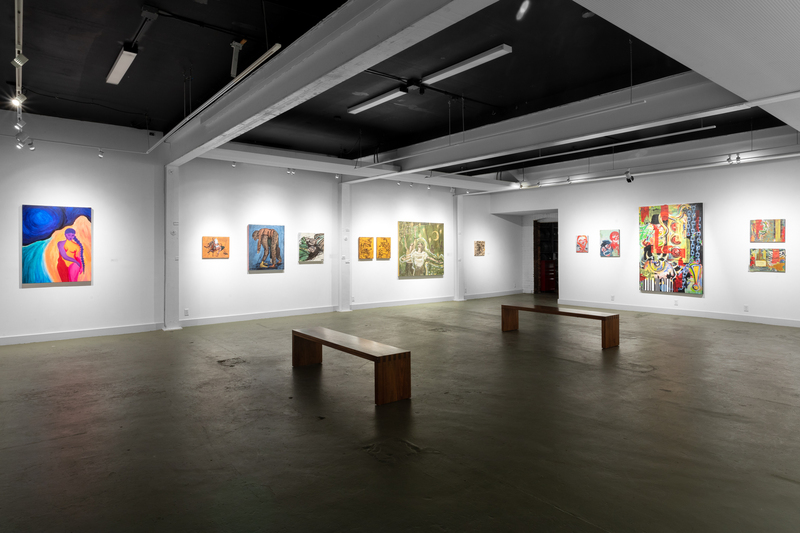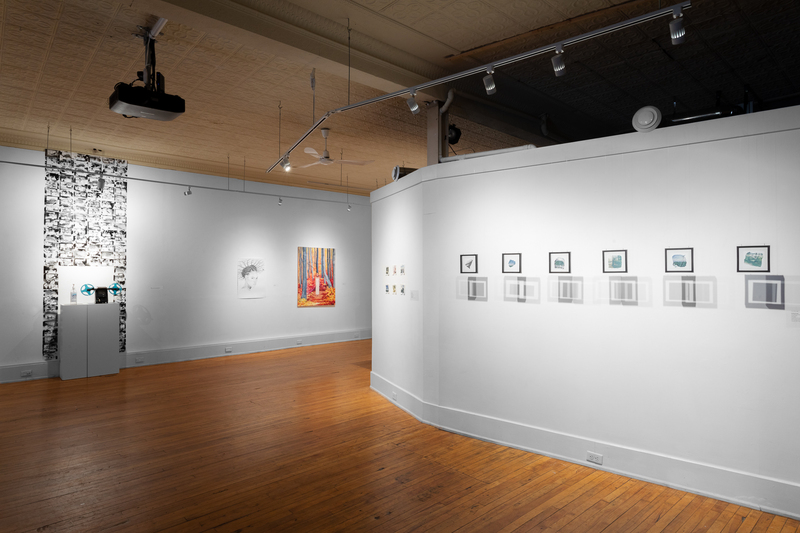Resurfacing: Exhibit Essay
RESURFACING
Learning and Mentorship
This year we celebrate the 4th year honours students of Spring 2022 at Brock University. During both semesters, the students of 4F06 forged many connections—chief among these were the speakers who met to share their experiences as practitioners, scholars, and teachers. These guest artists included: Monica van Asperen, who spoke on a wide range of topics from First Nations to the community of artists in Argentina; Tyler Durbano, who talked about various projects related to identity and gender (through the medium of hair); Risa Horowitz, who communicated the importance of resilience and detailed her practice in the act of making things; and Dianne Bos, who provided a survey of her work, which has spanned decades. All of these artists/mentors were selected for how their work related to each student’s practice, and how it expanded on our discussions of the dominant themes highlighted in the class.
In their first semester, the students participated in an excursion to Toronto to see the vibrant exhibitions at the Art Gallery of Ontario (AGO) and the Museum of Contemporary Art (MOCA). At the AGO, Julie Crooks’ curated exhibition Fragments of Epic Memory allowed the students to encounter narratives expressed through historical and contemporary artists working within the Caribbean Diaspora. Concurrently the show entitled GTA21 at MOCA featured 21 artists and collectives working with large-scale installations that celebrated critique, storytelling, and making. The docents, curators and volunteers at both venues made the trip informative and enjoyable, as did our nimble bus driver Barry, whom we lovingly called “Barry Allen” (the Flash) because of his curious ability to get us to our destinations on time.
The Exhibition
The works in this final exhibition represent a milestone for the students of 4F06. The unveiling of these works results from two semesters of research and practice that shows the range of material interests, from acrylic painting to natural dyes and inks to handmade paper, wood carving, textiles, and methods of wet-process photography. In each case, the mediums chosen by each student mirrored equally diverse concepts. Together these pairings generated potent forms of engagement by finding a home within social history, diversity, and numerous working methods. Moreover, these material processes used by the students often collided with mass fabrication within a globalized world of capitalized post-Fordist labour. As a result, handmade practices have resurfaced within the post-industrial economy context and are reborn as a testament to how each artist connects with material production. For instance, Naomi Egbunike’s paintings and drawings focus on braided hair politics and allow insights into the sensitive nature of her experience as a settler of African descent. In these works, we glimpse her formative years in Nigeria, where elements of the environment fuse with cultural expressions. As she indicates in her statement, “I continue to be fascinated by these comparisons, and this project revolves around all the possible ways I can blur the line between Black women, Nigerian culture, and nature—both conceptually and literally—to create a mesmerizing whole.” In many of her works, hair transforms into tree roots (or vice versa), and the very concept of these entanglements sets the stage for thinking about our place among traditions, rituals, and political engagements. The methodical act of braiding and thinking, as a process, allows a conceptual leap where the act of making is an act of caring, where cultural roots become hair roots become plant roots. We can also see many associations to African American Artist Sonya Clark’s braided hair works, where even the act of hairdressing is akin to textile art and proficiency in weaving. Hairstyling also makes reference to hair salons and barber shops, where topics of the day are discussed at length as processes of social exchange, just as exhibition venues set up public discussions and promote dialogue.[i]
In Egbunike’s drawings, attention is paid to aesthetics insofar as beauty is within the details and the forms that usher forth from the paper. There is a kinship to Rabia Choudhary’s painted works where inner struggles play out within an array of colourful “vulnerable” figures and where the power of female identity is inter-generational and ancient. As she notes in her statement, “My work depicts experiences and struggles with tenderness, love, growth, and reclamation in regard to conflicting identities.” In this way, Choudhary can navigate the complexities of place and displacement. In these works, there is no clear answer to the struggles of identity except to be able to show how these play out within the vibrant colours, symbols, and Islamic patterns composed with great care. Her hand-fabricated paper works, in material contrast, elucidate family histories from her native Pakistan, where the paper fibres mingle with the calligraphic Urdu letterforms that speak volumes about self-reliance and learning through making. These are more subtle gestures that have monumental meanings. In The New Politics of the Handmade, artist Anthea Black and curator Nicole Burisch speak about a resurgence of craft where “Craft in all its forms, remains a mode of production that is intimately tied to [the] adaptation of identity, culture and survival to meet personal and other collective needs.”[ii]
All of the artists in the exhibition offer these recontextualized events to understand the subject’s identity through the lens of relationships and familial ties by reclaiming past practices that have often come out of gendered contexts. For example, in Julie Luth’s work, film footage encompasses themes as diverse as contamination, everyday life, family history/genealogy, set amid postdigital wet process photography and mechanical supports. Surrounding lost and found materials, the artist enlists a process of recovery, archiving, and recontextualizing the past.
The isolation during the pandemic irrevocably changed the way we now live as the glowing screen fed us information about the outside world.[iii] To quote philosopher Jacques Derrida, “What is no longer archived in the same way is longer lived in the same way. Archivable meaning is also and in advance codetermined by the structure that archives.”[iv] I suspect that Luth’s work ties this notion of seeing and viewing through the lens of obsolete technologies. In particular, Nothing Can Kill 100% of Germs represents an invitation to the viewer to almost forensically examine the dust, dirt, and hair within a restored slide viewer and found film. In this work, the personal is political and indeed genetic. However, there is also something else at work in Luth’s compositions and those of Charelle St-Aubin’s that have to do with how artistic practice operates in the Anthropocene. Within this broad context, it was essential for both artists to use thrifted materials and find new directions for their work by looking at previous methods for creating photographic images outside the impulse to adopt the latest technologies. Another commonality was to think about participation to promote interest and exchanges between the public, labour, processes of making, and community. This urge to involve audience participation draws on long-held associations within cultural practices that involve ritual and touch by generating meaning through public use, activating the work in present contexts. In St-Aubin’s work, A Place to Share Memories the public is invited to overlay paper onto a carved table and go through a process of creating graphite rubbings of the underlying images. The creative act is extended and shared by having the work situated in an ongoing discovery process through public engagement. In St-Aubin’s work, she revisits domestic objects by incorporating a table and chairs, carving into them precise personal images. The seats of the chairs are covered with cyanotype photography fabric and imbued with embroidery; she speaks to the connection between social and family history through the lens of assemblage and storytelling.
In discussing many of the works in the exhibition it may be helpful to use the term “Femmage.” Coined by Canadian-born artist Miriam Schapiro and artist Melissa Meyer to examine these theoretical threads further, “Femmage” may be applied to many of the works in the exhibition that use historically conceived female domestic activities. According to curator Elissa Auther, “Schapiro’s conceptualization of ‘Femmage’ was an attempt to counter ideologies of domesticity and femininity with an assertion of the everyday that acknowledged women’s domestic agency and experience, especially in textile production.”[v] Many of these concepts relating to domesticity resurface as themes of empowerment.
After speaking with the students to understand the direction of their work, I couldn’t help but start to draw symbolic and even formal connections between their pieces. To use artist Barbara Kruger’s borrowed phrase from second-wave feminist thought, the “personal is political” becomes something exemplified in Sarah Formosa’s work, where personal stories of relationships become entangled with the sometimes-messy mediums of paint and drawing as exemplified in the works Expensive Lessons and Dead Weight. In these paintings, figures emerge not only as a gut reaction to loss, but as a description of what transpired and as a way to work through the stress brought about by relationship woes through the act of painting itself. We also see this thematic tie in the works of Cherilynn Tilley, whose unique combination of street art aesthetics with personal stories navigate the tricky juxtaposition of signs, text, symbols, colour and gestures. The medium of paint is as fluidly adept a material to propagate ideas as any. It can become a radical and visionary thing as a singular medium. In each case, there is no reverence placed on historicizing a particular period; instead, the artists favour themes of displacement and atemporality, bringing to the fore a kind of disrupted realism.[vi] In this sense, scale and many design principles are no longer as revered as they once were. Instead, Tilley and Formosa regard painting as an extension of ultra-personal experience in their search to be bold and challenge long-standing narratives and forms (within patriarchal constructs). Tilley’s work also emphasizes how symbols coexist with deeply abject depictions, provoking a response while positing ideas that are sometimes at odds with each other by blending words and images. Whether text is pasted on the canvas or reworked and obfuscated by the quick brush strokes, it suggests an urgency to repopulate the visual lexicon with something better. Finally, there is some irony in terms of the trauma alleviated by the act of creation. Artists have frequently been able to find ways out of stressful situations by creating something “new.” Compared to the many isolated people during the pandemic, I can’t help but think that the allusions to folk and street art are something Tilley considered within the broader present context of class, social status, and social justice.
Concurrently we see feminist issues examined in Kimberley Rogers’ work. In her paintings, post-pop compositions are populated by product placements that have connections to gendered family narratives revealed through the juxtaposition of consumer items that fill her canvases. In many of Rogers’ portrayals, the Western art historical canon (in this case, marble statuary) are fused with the unmonumental images of ephemeral packaging. By extension, the larger paintings find their way into other forms like zines or online content, something Rogers acknowledges as inevitable in a world where the trade of icons, symbols, and signs is unrelenting. At the same time, the link between the other artists in the exhibition is more evident by blurring the divide between “high” and “low” art. This critique has been raging since the birth of the avant-garde, when “found” objects were placed within gallery spaces designed to discuss, examine, and maintain cultural significance. The sculptural work within Roger’s practice directly references the female body as a commodity. The resurfacing of the mannequin work in pennies represents how a body might be viewed, objectified, and hence marginalized.
The resistance to dominant themes in favour of personal stories runs through many of the works in this exhibition. As a result, individual narratives resurface to assert themselves as a counter to the pandemic era’s streamed content, often set adrift in a sea of fantasy stripped of its moorings to reality.
Troy David Ouellette
Assistant Professor, Visual Arts
Department of Visual Arts,
Marilyn I. Walker School of Fine and Performing Arts,
Brock University
[i] It’s important to note how hairdressers and barbershops become spaces to speak about combating racial discrimination—especially within the southern United States. In You Next: How Black Barbershops Save Lives, author Antonio Johnson highlights the role of Black barbers as stewards for “shaping identity and maintaining barbershops as physical sites for community, thought and expression.” Drew, K., & Wortham, J. (2021). Black Futures. One World. p.389.
[ii] Black, A., & Burisch, N. (2021). The New Politics of the Handmade: Craft, Art and Design. Bloomsbury Visual Arts. p.9.
[iii] Here can also be found a connection to Mono-Ha that emerged in Tokyo in the 1960s and expounded upon the idea that an artist’s ability to make things had been nullified by technology. Tate. (n.d.). Mono-ha. Tate. Retrieved March 29, 2022, from https://www.tate.org.uk/art/art-terms/m/mono-ha.
[iv] Derrida, J., & Prenowitz, E. (2005). Archive Fever: A Freudian Impression. The University of Chicago Press. p.18.
[v] Auther, E., “Miriam Schapiro and the Politics of the Decorative.” Surface/Depth: The Decorative After Miriam Schapiro. The Journal of Modern Craft, vol. 12, no. 1, 2019, p.78.
[vi] According to curator Laura Hoptman, atemporality was first identified by Canadian author William Gibson as “a strange state of the world in which, courtesy of the internet, all eras seem to exist at once.” Hoptman, L. (2014). The Forever Now: Contemporary Painting in an Atemporal World. Published in conjunction with the exhibition The Forever Now: Contemporary Painting in an Atemporal World, December 14, 2014 - April 5, 2015, at the Museum of Modern Art, New York. Museum of Modern Art. p.13.


